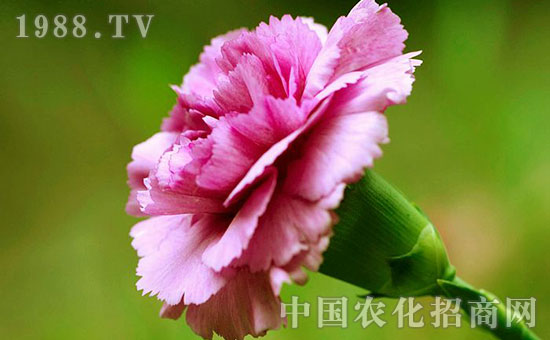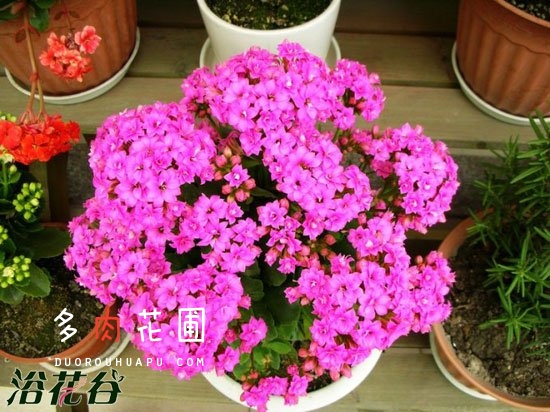Prevention and treatment of leaf spot of carnation
Carnation leaf spot, also known as branch rot, stem rot. It is the world's most serious disease that harms carnations, as well as American carnation, carnation, eversummer carnation, soap grass and so on. Areas that breed carnations in Shanghai, Hangzhou, Guangzhou, Kunming and southern Jiangsu Province are also affected by the disease.
(1) symptomatic pathogens infect leaves, stems and buds. Most of the disease starts from the lower leaves, the disease spot is round, oval, irregular, with a diameter of 4mur5mm, sunken reddish brown and gradually turning grayish white. In severe cases, the disease produces a black mildew layer (conidia), and the leaves are withered and drooping, but do not fall off. Branch blight occurs when the disease spot grows on the stem and is girdled. When the bud is infected, there are round spots on the bud and a black mildew layer, and disease spots on the branches, causing the bud to die.
(2) the pathogen is semi-known subphylum Alternaria. The conidia were separated longitudinally and horizontally, and the optimum temperature for growth was 26 ℃.
(3) regular occurrence of bacteria overwintering in diseased remains with hyphae and conidia. The disease began in June of the following year, and the disease was the most serious from August to September. The spores were spread by wind, rain and irrigation water. From the wound, stomata or directly invade the plant. In the mildew and rainy season and the year with more Rain Water, the disease is easy to spread. Too dense cultivation is also prone to disease, planting in the greenhouse can cause disease all the year round, and aging leaves are also susceptible to disease. According to the observation of Shanghai Botanical Garden, Beijing fine-leaf varieties are more resistant to disease than local broad-leaf varieties. Varieties with soft grass, wide leaves and large flowers are susceptible to disease.
(4) Prevention and control methods
1. Disease-resistant and resistant varieties were selected.
2. Strengthen management, pay attention to wiping buds and pruning, remove diseased leaves, spray or apply 1% Bordeaux solution, or 50% carbendan 500 times solution, or mancozeb 500 times solution, or 75% chlorothalonil 500 times solution, spray every 1 week or 2 weeks. Keep the light transparent.
3. Avoid spraying water on the plant.
4. The effect is obvious when sprayed with 1V / L / 100 Bordeaux solution for 5 times, and 1000 times of Dysenamine has a certain effect.
5. The effect of rotation with rice is good.
6. Increase the application of phosphorus and potassium fertilizer to enhance disease resistance.
Symptoms of carnation leaf spot and prevention and treatment of carnation leaf spot
Carnation is the mother flower of our country. During the growth cycle of carnation, carnation is prone to leaf spot disease. Below, the editor of China Agricultural and Chemical Merchants Network shares the symptoms of carnation leaf spot disease and the prevention and treatment methods of carnation leaf spot disease.

Carnation is an excellent variety of cut flowers. Dwarf varieties can also be used for pot ornamental. Flowers can also carry flavors. It is widely cultivated for ornamental in our country. The following editor will introduce to you the prevention and treatment skills of carnation leaf spot disease.
Symptoms of carnation leaf spot
It often occurs on leaves and stems, and sometimes on buds and flowers. Most of the disease on the leaves starts from the lower part, which first produces small round spots like light green water stains, and then gradually turns purple. With the enlargement of the lesion, death occurred in the center of the spot. The edge is brown, the spot is round, oval or irregular, about 4-5 mm in diameter, the central dead part is grayish white to gray, and later produces a black mildew layer on the spot. When the plant was seriously damaged, the leaves withered and drooped, but did not fall off. on the branches, the disease spots surrounded the stems or branches for a week, the upper branches, leaves and buds withered and died.
The occurrence regularity of carnation leaf spot disease:
The disease can occur from early April to early winter and can occur all the year round in greenhouse, especially in midsummer and rainy season. If it is planted too densely, it will spread quickly. However, the disease is less common in the north.
Prevention and treatment of leaf spot of carnation
1. When planting, disease-free branches should be selected from robust plants to prevent the first infection of pathogens, and fine-leaf varieties with strong antibacterial ability can also be introduced.
two。 After picking the buds and cutting the flowers, you can choose the liquid of 800 murine shark, 2000-3000 times of Penicillium and 75% chlorothalonil, and the effect is very good. If the disease occurs during the growing period, diseased leaves or diseased plants should be removed in time, and the above-mentioned agents should be sprayed to prevent the spread of the disease.
Prevention and control of carnation leaf spot carnation is a perennial herbaceous flower. Originated in Europe and the United States, since it was introduced to China, because of its large color and beauty, it is often cultivated in greenhouse for the production of fresh cut flowers, but it can also be cultivated in open fields in flower beds, which is very popular. However, carnations are easily infected with leaf spot disease and affect its growth and development, so it is necessary to talk about the prevention and treatment of leaf spot disease of carnations. The pathogen of carnation leaf spot overwinters on the remains of diseased plants with hyphae and molecular spores and can survive in the soil for about a year. When the temperature rises and the leaf surface is moist for a long time, the pathogen is easy to grow rapidly. The optimum temperature for mycelial growth was 25: 30 ℃ (the best at 26 ℃). The molecular spores began to germinate at 18: 27 ℃ (the best at 24 ℃) and spread through air flow and water, invading from stomata, wounds or directly. The incubation period was 10 ℃ for 60 days. Therefore, the disease can occur in greenhouse cultivation every year, and in open field cultivation from April to November. The disease occurs in leaves and stems, and sometimes in flowers. When the disease occurs on the leaves, the disease spot is a light green water collapse-like small round spot, and gradually expands into a near-round, oval or long-shaped spot, becoming purplish brown, slowly withered in the center of the spot, turning into gray, and the whole leaf is twisted and hung upside down on the stem. When the disease infects the stem, it often occurs at the fork of the branch and the wound caused by picking the bud. The disease spot is long and grayish brown. In severe cases, the disease spot cuts the stem, withering the upper branches and leaves. When the disease infects flowers, it often causes harm on pedicels and bracts. When there are many disease spots on bracts, flowers can not open or appear deformities. Control measures: ① cuttings without disease were selected during cuttage propagation to eliminate diseased bodies; ② rotation was carried out in places with good ventilation and good drainage for more than 2 years as far as possible. ③ sprays preventive fungicides once a week, especially after picking buds and flowers, using 75% chlorothalonil, 50% carbendan 500x or 1% Bordeaux solution.
- Prev

How to plant longevity flowers?
Longevity flower is a succulent plant of Sedum family, with thick and bright leaves, dwarf and evergreen plants. It blossoms in winter and spring, and the flowering period is as long as 4 months. There are many flowers, each branch can reach several flowers. It is suitable for 12-15 cm potted plants. The sex likes the warm climate, the suitable temperature for growth is 18-30 ℃.
- Next

What physiological diseases are easy to occur in the process of carnation cultivation? How to reduce the occurrence of these diseases?
The main physiological diseases in the cultivation of carnation are calyx rupture, flower head bending, albino leaves and so on. Especially the first two items can significantly reduce the quality of cut flowers. (1) Calyx ruptured. The large gear train is more prone to calyx rupture than the medium gear train, and sometimes more than 50% of the diseased flowers occur.
Related
- Fuxing push coffee new agricultural production and marketing class: lack of small-scale processing plants
- Jujube rice field leisure farm deep ploughing Yilan for five years to create a space for organic food and play
- Nongyu Farm-A trial of organic papaya for brave women with advanced technology
- Four points for attention in the prevention and control of diseases and insect pests of edible fungi
- How to add nutrient solution to Edible Fungi
- Is there any good way to control edible fungus mites?
- Open Inoculation Technology of Edible Fungi
- Is there any clever way to use fertilizer for edible fungus in winter?
- What agents are used to kill the pathogens of edible fungi in the mushroom shed?
- Rapid drying of Edible Fungi

